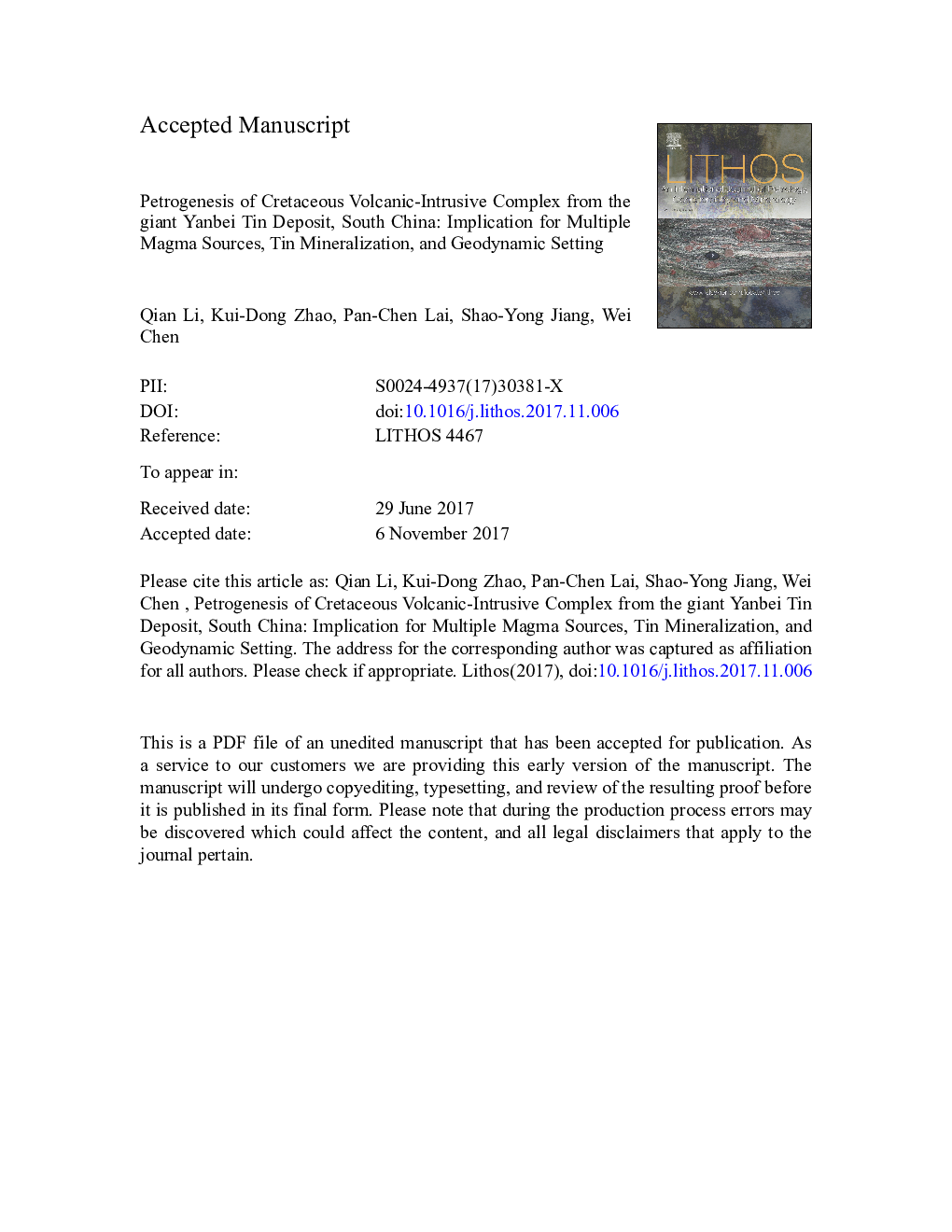| کد مقاله | کد نشریه | سال انتشار | مقاله انگلیسی | نسخه تمام متن |
|---|---|---|---|---|
| 8911796 | 1638624 | 2018 | 64 صفحه PDF | دانلود رایگان |
عنوان انگلیسی مقاله ISI
Petrogenesis of Cretaceous volcanic-intrusive complex from the giant Yanbei tin deposit, South China: Implication for multiple magma sources, tin mineralization, and geodynamic setting
ترجمه فارسی عنوان
پتروژنز از مجتمع های نفوذی آتشفشانی کرتاسه از رسوب بزرگ قلمه یانبی، جنوب چین: تأثیر برای منابع مختلف ماگما، کانی سازی قلع و محیط ژئودینامیک
دانلود مقاله + سفارش ترجمه
دانلود مقاله ISI انگلیسی
رایگان برای ایرانیان
موضوعات مرتبط
مهندسی و علوم پایه
علوم زمین و سیارات
ژئوشیمی و پترولوژی
چکیده انگلیسی
The giant Yanbei tin ore deposit is the largest porphyry-type tin deposit in South China. The orebodies are hosted by the granite porphyry in the central part of the Yanbei volcanic basin in southern Jiangxi Province. The Yanbei volcanic-intrusive complex mainly consists of dacitic-rhyolitic volcanic rocks, granite, granite porphyry and diabase dikes. In previous papers, the granite porphyry was considered as subvolcanic rocks, which came from the same single magma chamber with the volcanic rocks. In this study, zircon U-Pb ages and Hf isotope data, as well as whole-rock geochemical and Sr-Nd isotopic compositions of different magmatic units in the Yanbei complex are reported. Geochronologic results show that various magmatic units have different formation ages. The dacite yielded a zircon U-Pb age of 143 ± 1 Ma, and the granite porphyry has the emplacement age of 138 ± 1 Ma. Diabase dikes which represented the final stage of magmatism, yielded a zircon U-Pb age of 128 ± 1 Ma. Distinctive whole rock Sr-Nd and zircon Hf isotopic compositions suggest that these magmatic units were derived from different magma sources. The volcanic rocks were mainly derived from the partial melting of Paleoproterozoic metasedimentary rocks without additions of mantle-derived magma. The granite porphyry has an A-type geochemical affinity, and was derived from remelting of Paleo-Mesoproterozoic crustal source with involvement of a subordinate mantle-derived magma. The granite porphyry is also a typical stanniferous granite with high F (4070-6090 ppm) and Sn (7-39 ppm) contents. It underwent strongly crystal fractionation of plagioclase, K-feldspar, and accessory minerals (like apatite, Fe-Ti oxides), which may contribute to the tin mineralization. The diabase was derived by partial melting of enriched lithospheric mantle which had been metasomatised by slab-derived fluids. The change of magmatic sources reflected an increasing extensional tectonic environment, perhaps induced by slab rollback of subducted paleo-Pacific plate.
ناشر
Database: Elsevier - ScienceDirect (ساینس دایرکت)
Journal: Lithos - Volumes 296â299, January 2018, Pages 163-180
Journal: Lithos - Volumes 296â299, January 2018, Pages 163-180
نویسندگان
Qian Li, Kui-Dong Zhao, Pan-Chen Lai, Shao-Yong Jiang, Wei Chen,
